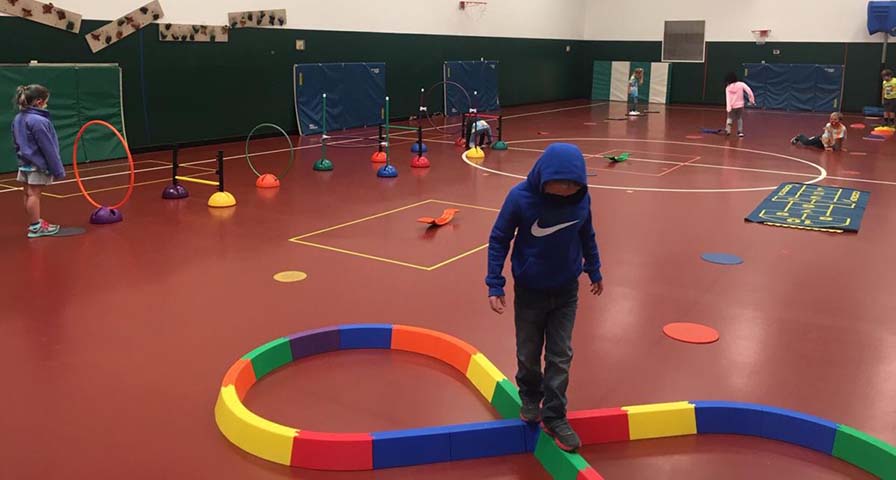Originally published Dec. 10, 2020 by The Greene County Record.
By Kathleen Borrelli
With all the stress and uncertainty of life during the COVID-19 pandemic, it is more important than ever to get fresh air and exercise as often as possible. Greene County PE teachers are finding new ways to keep kids active this year while social distancing.
“This year is no different in that students need and greatly benefit from physical activity during their school day, whether in person or virtually,” said Ruckersville Elementary School PE teacher Stacey Powdrell. “It helps combat stress, gives their brains a break and stretches out their bodies. Yes, we’ve had to make some changes to the way we are doing PE this year, but that’s what we’re trained to do as educators—reflect, adapt and modify.”
 The PE teachers at all five schools have found ways to modify their activities to allow for social distancing among participants.
The PE teachers at all five schools have found ways to modify their activities to allow for social distancing among participants.
“It started with organizing the physical gym space,” Powdrell said. “Instead of using what we’ve called ‘Eagle dots’ in past years, I created ‘Eagle nests’ that were 6 by 6 and 10 feet apart, using floor tape. Each student has their own nest to stay in. I’ve also made equipment adjustments, whether it’s making sure we have enough for each individual student, implementing a used and unused pile instead of sharing, or switching the type of equipment; pool noodles have been a lifesaver as they allow us to play some of the old games they love while helping to maintain the distance requirements.”
In addition to in-person lessons, RES PE teachers have created engaging and fun videos that can be used at home or at students’ desks. “Some of our favorites seem to be ‘this or that’ exercise videos, video game workouts where students have to dodge items on the screen, and desk cardio drumming which combines exercise and rhythm,” Powdrell said.
“As an educator I’ve tried my best to be someone who is adding fun, bringing some energy and creating opportunities for laughter this year,” she continued. “It’s very easy to get overwhelmed by all that we’re having to do differently and the weight of all the extra hats that we’re all wearing, but at the end of the day I want to be someone who is honest about those things but doesn’t let them stop her from making a positive difference in the lives of our kiddos and throughout our school community, even if that means dressing up in our Eagle costume for spirit week or dancing like a fool every morning to welcome students back into the building.”
At Nathanael Greene Primary School, Joshua Mitchell’s kindergarten and first-grade students also exercise in taped-off ‘activity boxes’ that are spaced 10 feet apart.
“Along with each box I have ‘activity buckets’ that include a variety of personal equipment for them to utilize, such as speed stacking cups, jump ropes, hula-hoops, bean bags, juggling scarves, etc.,” Mitchell said. “Along with using our activity boxes, we’ve been able to do some hands-free obstacle courses focusing on balance and moving via different pathways. Any activity we do this year outside of our activity boxes will have to be hands-free and turn-based so as to maintain appropriate spacing.”
Because some of the primary school students are still learning virtually at home, Mitchell has smaller class sizes, which allows there to be enough equipment to designate items to individual students.
“While this year is very different, the kids are still having a blast and are all so excited to see what new activity we will be focusing on for each particular week,” he said. “These kids are quite adaptable and resilient and I love providing them the opportunity to be physically active.”
Since fifth-graders are now housed at William Monroe Middle School to allow for appropriate spacing in the younger grades (which currently have more in-person learners), four busy PE teachers serve all of the fifth- through eighth-graders on a rotating weekly schedule.
“Because we are all teaching face to face, there’s no synchronous PE classes for the virtual students,” said WMMS teacher Katie Marshall. “We do have a grant for a software called Focus Fitness, and within that software they can do activity logs, they can do sleep logs, hydration logs … I have a start date and end date and then all four of us go in and look and see who is completing stuff and who’s not.”
With the middle school students, Marshall says the focus has been on individual health and conditioning and learning to be more self-reliant.
“We teach them … not that their grade doesn’t matter but that they should either choose to do something or choose not to do something based upon their health,” Marshall explained. “We did dance all month in October. One of the days we did Halloween dances and I (told them) you might not like dance, but it’s great cardio so it’s good for your heart, good for your lungs, lowers your chances for diabetes, heart attack and stroke. Dance has been known to help with even Alzheimer’s and dementia patients, so there are a lot of benefits. We try to not worry about the grade as much as the health benefits to doing a certain exercise or activity.”
In the middle school gym as well, kids do exercises while standing on an X that is marked with tape spaced out 10 feet from one another.
“We’ve done dance, we’ve done yoga, we’ve done Pilates … we have these booklets that have different exercises where the students get to choose which exercises they want to do for the time limit that we have,” Marshall said.
With a new shipment of PE equipment recently received by the middle school, students in Marshall’s class will now be working on jump rope, kettle bells and cardio drumming. The schools have purchased large backpack-style disinfectors which they use to sanitize all PE equipment in between classes, and with modified class schedules there is enough time for all equipment to sit and dry in between class groups.
Marshall says the individual conditioning will still help students to be better team players once they are able to play cooperative games and sports again in the future.
“I think this year is a lot more of building confidence in your own abilities,” she said. “I have my own jump rope, I have to worry about my own stuff, and so it’s building self-confidence. Because when I have self-confidence, then I’m a better team player because I don’t sit on the sidelines. We’re hoping by doing this this year, if we ever get back to ‘normal’ and we can play team sports, we will see more teamwork and better participation in our team activities because we’ve helped boost their self-esteem, their self-worth, their self-image by doing individual stuff this year.”
Although middle school students only have PE twice a week on alternating weeks—on other weeks they may have music or other related arts—Marshall thinks the community has really stepped up by offering weekly karate classes in the park and with the extreme popularity of hiking and camping this year to keep kids and their families moving.
“Ultimately, we want them to be able to leave our class and choose to be physically active in whichever way they want to be,” she said. “If that means to continue on with sports, then continue. If that means they’re going to go to the gym every other day, or they’re going to go swimming or hiking … our job isn’t to make them just move; it is to make sure that they keep moving even when they’re not with us.”
William Monroe High School students who are 100% virtual also record physical activity logs each week for virtual PE, according to department chair and adaptive PE teacher Teresa Collier.
“They are definitely learning that deciding what they will do for exercise and how to fit it in to a busy schedule is a bit challenging—I think most adults would agree,” Collier said. “During our live Zoom sessions we talk about fitness concepts, how to organize and manage time and how to be healthy for a lifetime.”
Blended students in the high school are currently doing driver’s education or health classes during their in-school instructional time and recording their required 150 minutes of activity during their asynchronous school days.
“For our virtual students, we really try hard to get them to interact with each other and their teachers in order to assist with the social-emotional aspects of being a teenager,” Collier said. “I’ve noticed that students seem less self-confident than they were before they were quarantined. However, we talk all the time about how just getting up and moving can improve our mood, ability to learn and overall health. As a matter of fact, in today’s live Zoom session we were discussing ways to move and get active while studying.”
With the difficulty of frequently disinfecting shared equipment and lack of space for adequate social distancing, in-school physical activity is extremely limited at the high school this year, according to PE teacher Kendall Tata.
“Students submit a fitness log to their teacher weekly,” Tata said. “The log requires them to engage in activity for two and a half hours per week including cardiovascular endurance, strength training and flexibility. It is challenging for the teacher to motivate and encourage students with this form of physical education, but we do the best we can and welcome students’ ideas.”
Tata hopes her students will take to heart the lessons about healthy physical activity during this challenging period in their lives.
“During the pandemic, many students stayed inside and were far less active,” she said. “While some embraced the outdoors and enjoyed hunting, fishing, running, hiking and many other outdoor activities, many of the students were home playing video games and doing other sedentary activities. The result of this sedentary lifestyle has contributed to health issues such as weight gain and apathy towards exercise … as a teacher, I miss hearing the laughter and seeing the spirit of fun and joy of being physically active among the students.”
In 2020 more than ever before, it is important for all of us to remember the necessity of physical activity for physical health as well as mental health, a fact which these teachers struggle to impart to students who are spending more and more time sitting quietly at desks or—all too often—in front of devices and screens.
“Pre-pandemic when in school, the students actively engaged in physical education daily for 45 minutes,” Tata said. “Even if the activity was not high-intensity they were up and moving, being social, cooperating with each other, exhibiting sportsmanship skills and learning about fitness. Since all of their fitness is now on their own, the camaraderie of doing fitness activities together is non-existent … the students are now learning to take charge of their own fitness and plan for lifelong health.”
Seeking information about the IHT Spirit System?




